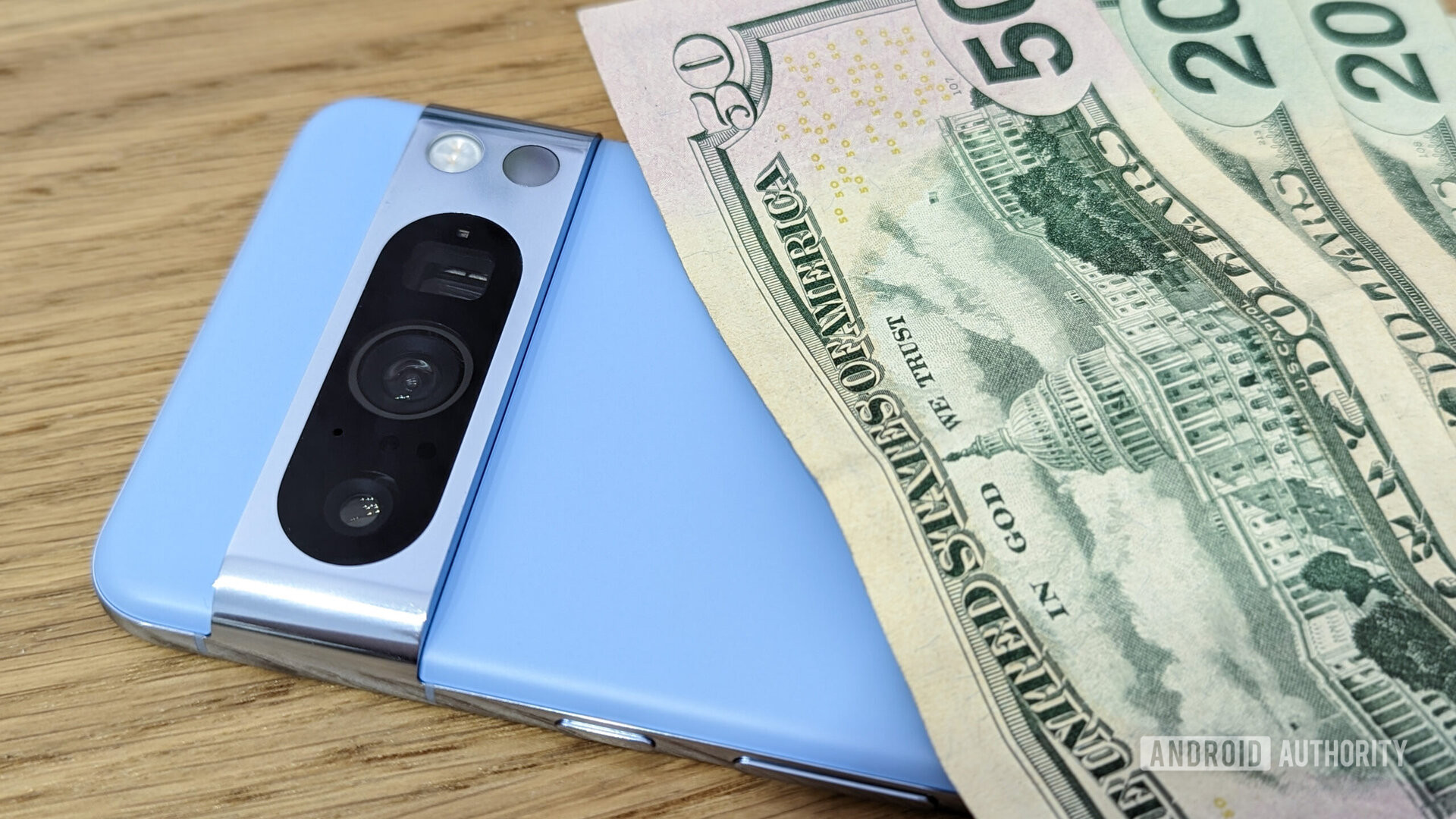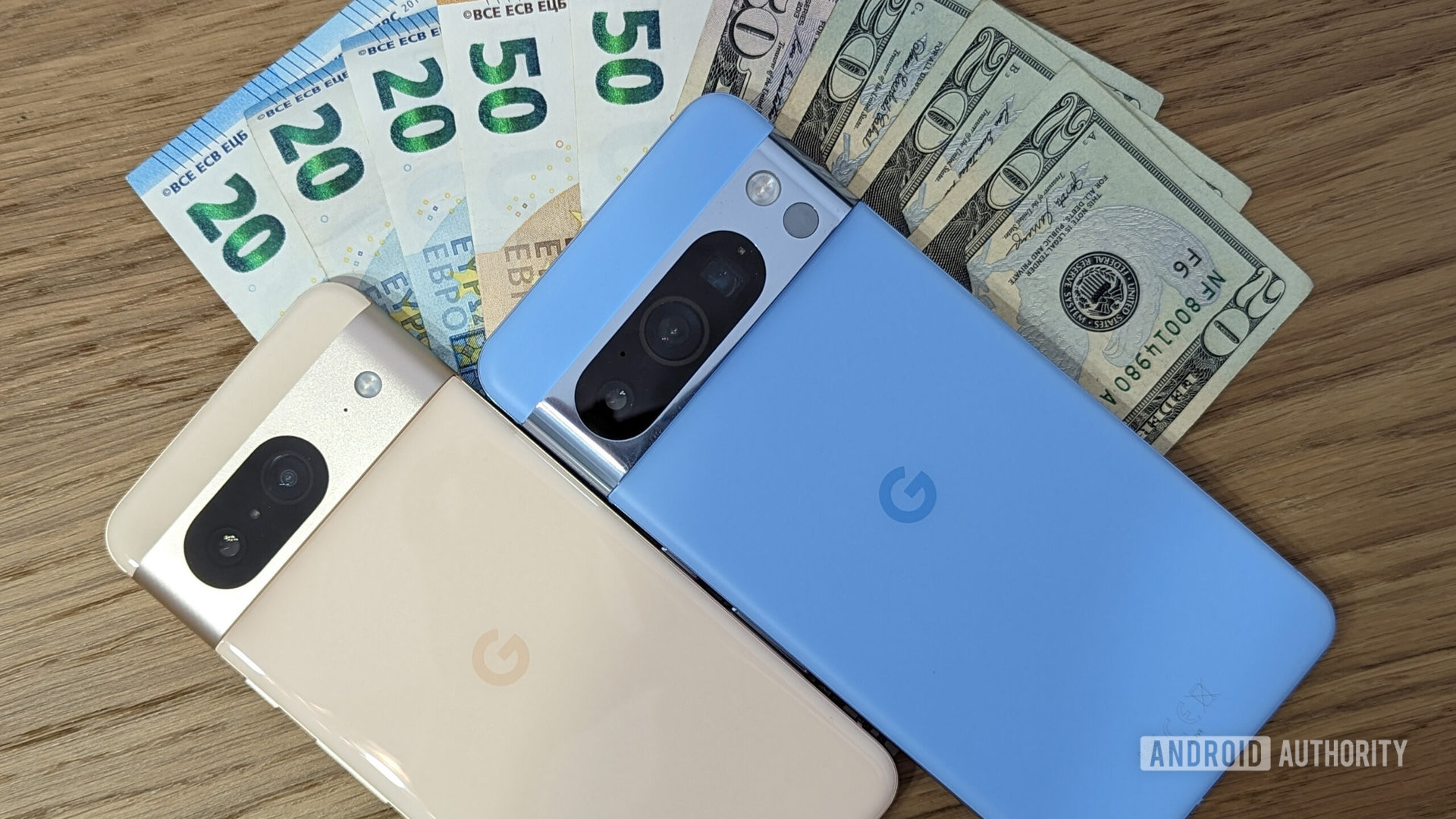Affiliate links on Android Authority may earn us a commission. Learn more.
We did the math: The Pixel 8 and 8 Pro aren't really overpriced
I’m pretty sure your jaw dropped when the Pixel 8 and 8 Pro‘s official prices were revealed earlier today, even more so if you live outside the USA. The US pricing for both Pixels has jumped up by $100, putting it closer to its tougher Galaxy and iPhone competition. But the sticker shock is even more important outside the US, where prices have been bumped up by up to €200 or £150. So what gives?

Fun, exclusive Android 14 customizations
Industry-leading update promise
I took my calculator, made a spreadsheet, and tried to make sense of those mad numbers. My original thought was to prove that the rest of the world was being stiffed with the new Pixel pricing — a €200 or £150 jump doesn’t seem as fair as a $100 increase — but I ended up finding a logical explanation for all of it.
Google took a big part of the financial hit last year and is now readjusting its pricing.
The tl;dr version? Google took a big part of the financial hit last year and has now readjusted (without over-correcting). You can mostly blame inflation rates for the Pixel 8 and 8 Pro’s price increases in the US; whereas the rest of the world can point its fingers at weaker conversion rates.
You can find the math below. And please, keep in mind that I’m not excusing Google for its higher prices, but laying out a financial reason for them. Whether that justifies the increase for you or you prefer if Google kept a more competitive price is your prerogative. I’d prefer more competitive pricing.
Are the Pixel 8 and 8 Pro overpriced?
Blame inflation and hardware updates for the Pixel 8 series’ US price

In 2021, the Pixel 6 cost $599 on launch, while the Pixel 6 Pro was priced at $899. Those prices remained the same in 2022, despite a >5% year-on-year inflation rate in the US on all goods. Without even doing the math, it’s easy to tell that Google was sacrificing some profits there to keep that identical price.
The story is different in 2023, with Google upping the price of each phone by $100. The inflation rate is only around 3%, though, so why the sudden increase? Well, that only makes sense when you cumulate both years’ rates (9.7%).
The cumulative 9.7% inflation increase between 2021 and 2023 explains the US pricing for the Pixel 8 series.
I took the base 2021 price for each phone ($599 and $899, respectively), and added the year-on-year inflation rate for the months of August. (Pixels are announced in early October and the most recent US inflation report available then is for August.) You can see the results in the table below.
| Official US price | YoY inflation rate | Projected price (2021 price + YoY inflation) | |
|---|---|---|---|
Google Pixel 6 | Official US price $599 | YoY inflation rate - | Projected price (2021 price + YoY inflation) $599 |
Google Pixel 7 | Official US price $599 | YoY inflation rate 5.8% (Aug 2021 - 2021) | Projected price (2021 price + YoY inflation) $633.74 |
Google Pixel 8 | Official US price $699 | YoY inflation rate 3.7% (Aug 2022 - 2023) | Projected price (2021 price + YoY inflation) $657.19 |
Google Pixel 6 Pro | Official US price $899 | YoY inflation rate - | Projected price (2021 price + YoY inflation) $899 |
Google Pixel 7 Pro | Official US price $899 | YoY inflation rate 5.8% (Aug 2021 - 2021) | Projected price (2021 price + YoY inflation) $951.14 |
Google Pixel 8 Pro | Official US price $999 | YoY inflation rate 3.7% (Aug 2022 - 2023) | Projected price (2021 price + YoY inflation) $986.33 |
Based on this, the Pixel 7 and 7 Pro should’ve cost $633 and $951 — certainly more than their official MSRP, which is why I said Google took the hit last year. The math says the Pixel 8 and 8 Pro should cost $657 and $986, respectively, which is pretty close to the $699 and $999 official pricing. The markup is higher on the base model, but it’s pretty spot-on for the Pro.
For Google, the price hike is justified by the all-around improvements and upgrades to the Pixel 8 series.
When we asked about these higher prices, Google obviously didn’t mention inflation, but focused instead on all the hardware and software updates to the Pixel experience that this eighth series is bringing. According to the company, the markup is justified by the refined designs and materials, upgraded camera lenses, brighter and better displays, Tensor G3 processor, along with all the new AI capabilities, and especially with the leading update policy of seven years. Promising to support a phone for three more years comes with a lot of development costs that had to be factored in somehow.
Blame conversion rates for the Pixel 8 series’ price outside the US

Since I live in France, I also care about the rest of the world (ROW) price of the Pixel 8 and 8 Pro. I’d already recommended these phones to several friends, hoping for a competitive price and a neat pre-order bonus, but I wasn’t expecting such an important markup. The Pixel 8 is €150 more expensive than the Pixel 7 here, and the 8 Pro is €200 more than the 7 Pro. Yikes.
Here too my trusty calculator and spreadsheet gave me a logical reason. I focused on the price in euros, pounds, Australian dollars, and Canadian dollars (I think a similar trend will be found across more countries and currencies). I found the conversion rate of each currency versus the USD on the date of the phone’s announcement, and I calculated how much each phone cost in equivalent USD in those markets. You can check the original spreadsheet if you want, but the more interesting bits can be seen in the graphs below.
For the Pixel 6, 7, and 8, a trend quickly appeared. Dollar for dollar, the Pixel 6 was ~20-30% more expensive in euros, pounds, and Australian dollars (all those prices include sales tax, which explains the large difference) and ~8% more expensive in Canadian dollars. When you consider shipping, different import/export fees, and simply wanting to round up the number, all of it makes sense.
That wasn’t the case with the Pixel 7. Google took a hit in 2022, with a significantly smaller difference, dollar for dollar. In Europe, for example, the VAT rate is 21% on electronics, but Google only marked up the price by 7% compared to the US one. The rest of the tax had to be taken out of the company’s base profit margin.
When you take currency rates and taxes into consideration, the Pixel 8 and 8 Pro are rationally priced outside the US.
The Pixel 8 price is, on paper, a readjustment back to normal for ROW pricing. Markup percentages versus the USD price go back to ~20-30% for euros and pounds, while the Australian and Canadian prices remain within the same margin of the US pricing as the Pixel 7.
The graph above shows an identical story for the Pro line-up’s price. Again, the Pixel 6 Pro had a higher price in Europe, the UK, and Australia, compared to the US, due to sales taxes. By keeping the same price tag for the 7 Pro the next year, Google also took a hit — so much so that it basically gave away the sales tax on its price in euros and Australian dollars. The Pixel 8 Pro is a return to more financially sound prices, with a ~7-20% markup in countries where sales tax is applied on the sticker price.
Of course, this explanation doesn't change the sticker shock when you check the Pixel 8 or 8 Pro's price.
This is all nice on paper, but it doesn’t help with the sticker shock when you open the Pixel 8 and 8 Pro’s product listings. It’s certainly going to be the first asterisk I mention when my friends ask me about the phone I told them to buy. I still think the two devices are good value for money in the pre-order stage, but they’re no longer playing with as big of a price advantage as in previous years. Without the pre-order bonus? Well, I’ll have to do the math, but we’re talking Galaxy S23 Ultra-money here, not even counting discounts on Samsung’s six-month-old phone, so you should really want an Android phone with a stock experience to get the Pixel 8 Pro.



